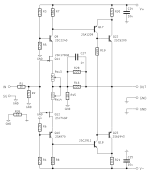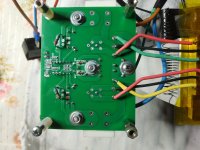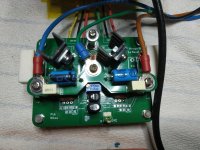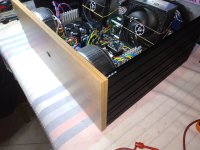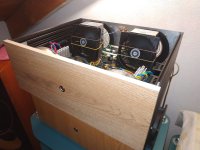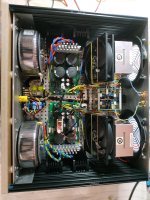gaborbela,
I had ordered the minimum number of boards (5). I donated a pair to a friend of mine and I will use another pair for my amps, so, unfortunately, there is only 1 left.
I don't think that it is costly to order from China (I ordered mine from JLCPCB). As far as I remember, the whole order (PCBs + shipping + [prepaid] taxes) cost something like 10-12 Euros.
You could raise the supply voltage in order to get more power, but I think you should keep idle current low.
Cheers,
Evangelos
I had ordered the minimum number of boards (5). I donated a pair to a friend of mine and I will use another pair for my amps, so, unfortunately, there is only 1 left.
I don't think that it is costly to order from China (I ordered mine from JLCPCB). As far as I remember, the whole order (PCBs + shipping + [prepaid] taxes) cost something like 10-12 Euros.
You could raise the supply voltage in order to get more power, but I think you should keep idle current low.
Cheers,
Evangelos
Is this schematic the same as the gerbers? If not, could knutn share the board's schematic?Hello, my Gerber files for the Hiraga version are free to use and are attached here.
Knut
Attachments
Wunderbar. What transistors did you use on the front end/driver stages?Yes, the PCB designed by Knut corresponds to this schematic.
Same as in the original, i.e.: 2SK170/2SJ74, 2SC1775/2SA872 and 2SB716/2SD756.Wunderbar. What transistors did you use on the front end/driver stages?
Yesterday, I tried playing with feedback. Le Monstre has a rather high CLG - 26 dB (20x). All of my other amplifiers are at the level of 20 dB (10x). So, I added a second 220 Ohm resistor parallel to the installed 220 Ohm feedback resistor and that lowered the CLG to 20 dB.
Next, it was time for a listening evaluation. For a quick comparison, I didn't solder the paralleled resistor, but connected it with a pair of cables with crocodile clips, in order to be able to readily connect and disconnect it. Well, it was clear to my ears that the lower FB was way better. With the higher FB, sound was less vivid and seemed to loose clarity.
So, I decided to stick with the original feedback scheme.
Cheers,
Evangelos
Next, it was time for a listening evaluation. For a quick comparison, I didn't solder the paralleled resistor, but connected it with a pair of cables with crocodile clips, in order to be able to readily connect and disconnect it. Well, it was clear to my ears that the lower FB was way better. With the higher FB, sound was less vivid and seemed to loose clarity.
So, I decided to stick with the original feedback scheme.
Cheers,
Evangelos
Same story here.... i change the resistor 10Ω to 20Ω.Yesterday, I tried playing with feedback. Le Monstre has a rather high CLG - 26 dB (20x). All of my other amplifiers are at the level of 20 dB (10x). So, I added a second 220 Ohm resistor parallel to the installed 220 Ohm feedback resistor and that lowered the CLG to 20 dB.
Finally setup for 4Ω version
+/- 22-24V
330pf input cap
Bypass resistor 68k
On 1k res cold 1.20V -1.34V
0.47Ω resistor bias 730 -750mv about 1.6A
220 -20Ω gain resistor
Offset +/- 2 mV
Trimmer 53-48 Ω
2sj74Gr -2sk170gr 3.0ma idss
Cascode 1845-992
Drivers 4793-1837
Output 1987-5359
Attachments
Last edited:
I think that has to do with lower output impedance at higher feedback level. I experiment with these kind of amplifiers for guitar, with less feedback the sound becomes more, let's say, 'dynamic'.With the higher FB, sound was less vivid and seemed to loose clarity.
let's say, 'dynamic
I would say more analytical and with more scene depth. For 4 ohm speakers always.
- Home
- Amplifiers
- Solid State
- Hiraga "Le Monstre"
